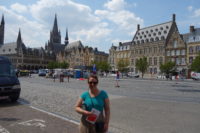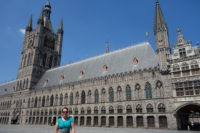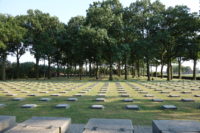 We bid farewell to our wonderful hotel in Ghent and splurged on a twenty-euro taxi to take us across town to pick up our rental car. We are usually adventurous enough to use public transportation, but we had luggage to deal with, and about a mile of walking to do even with using the tram. Sometimes money buys you time and ease, so we used a cab. After a few minutes with a very pleasant car rental agent, we were on our way north to Ypres and the Flanders Fields area, in the heart of a major World War 1 front line.
We bid farewell to our wonderful hotel in Ghent and splurged on a twenty-euro taxi to take us across town to pick up our rental car. We are usually adventurous enough to use public transportation, but we had luggage to deal with, and about a mile of walking to do even with using the tram. Sometimes money buys you time and ease, so we used a cab. After a few minutes with a very pleasant car rental agent, we were on our way north to Ypres and the Flanders Fields area, in the heart of a major World War 1 front line.
While Ghent negotiated a peaceful occupation with the Germans and, as such, the town survived intact, the town of Ypres (“Ieper” in Flemish) was right on the stalled front line of the war for four years and was completely destroyed. Amazingly, the people of Ypres rebuilt the town according to the original plan, including rebuilding the massive town hall, Cloth Hall, and the enormous nearby cathedral. Cloth Hall now houses the tourist information office, and a large museum dedicated to WWI, focusing on the Flanders Fields area. We were helped in our efforts to see the museum by a kind man who informed us that where we had parked was a no-parking zone in half an hour. The town was setting up a community viewing area for the Belgium-England World Cup game that evening, and we were parked there. We were very grateful for his letting us know and ended up finding street parking before going to the museum.
 The museum was one of the best museums I have ever been in. It was well laid out, with artifacts from the war, video recreations of actors telling individual stories, maps, well-presented written information, and special bracelet-activated kiosks that tried to find people like you from the war to tell their stories. That proved a little tricky to do for a forty-seven-year-old man from the US, but I still liked the idea of personalizing the experience for each visitor.
The museum was one of the best museums I have ever been in. It was well laid out, with artifacts from the war, video recreations of actors telling individual stories, maps, well-presented written information, and special bracelet-activated kiosks that tried to find people like you from the war to tell their stories. That proved a little tricky to do for a forty-seven-year-old man from the US, but I still liked the idea of personalizing the experience for each visitor.
The museum presented things mostly in chronological order, with some groupings of topics (like trench warfare, weapons and uniforms, medical care, and so on). It started with the pre-war issues of the countries involved, which mainly seemed to boil down to intense nationalism (we saw children’s games where you were to shoot the Hun in the butt), international stress of expanding colonies world-wide, and an arms race as armies got bigger and better equipped.
Except the poor Belgian army. They were supposed to be neutral in Europe, and had an army of mostly volunteers equipped with outdated gear. The saw what was going on around them, and just deployed their army to defensive positions only four days before Germany invaded. They were quickly overwhelmed, although they did have some success with newer weapons against older strategies – a small bicycle machine-gun unit held off an elite cavalry unit from Germany. France’s war plan had not anticipated Germany invading Belgium (a mistake they would make again in twenty years for WW II), and so it took them two weeks to deploy, along with the English. As such, Germany advanced quickly across much of Belgium, although not so quickly as they had planned. Once the Belgians deliberately flooded parts of northern Belgium as a defensive measure, and once the French and English got deployed, the war settled into trench warfare for four more years, centered in this area around Ypres.
The museum did a great job of capturing the horror of the war, showing pictures of the devastation. Many trench areas were barren wastelands of mud with a few stumps scattered in amongst craters from shells. Men had to lay down wooden planks to walk on because the mud was everywhere. The Germans tended to build shallow concrete bunkers in which to sleep and hide during shelling attacks, while the British dug tunnels twenty-five feet or more underground. In either case, the men slept packed together. The trenches were rat-infested and usually had some water in the bottom, so that it was hard to stay dry. Boredom for the men at the front was an issue, and officers would order occasional raids just to keep morale up, despite heavy casualties incurred during these raids. It was a miserable existence.
All in all, the museum was fantastic, and I was sad we only had time (three hours) to do the main museum. We left off the archaeology museum and climbing the Cloth Hall bell tower, largely because our parking meter was up. This is one time when the town would have been wise to have free parking, since we would have stayed longer and spent money on supper.
Leaving Ypres did give us time to visit a few other places nearby. We went to the town of Zonnebeke, which is home to the Passchendaele Museum and Memorial Gardens. Passchendaele is the name of a nearby town, but the whole region was the site of a massive British offensive that failed in its objectives. It was supposed to be a breakthrough battle to capture the coastal German submarine ports, but instead got mired down and took three months. The British and German casualty numbers are disputed, but seem to be about 250,000 dead and wounded on each side (500,000 total).
The museum there is supposed to give an idea of trench life, but we did not get to see it. We got to Zonnebeke close to 4:00 without having eaten, so we grabbed a picnic lunch and then ate near the museum, which was in a lovely park. By the time we were finished, it was almost 5:00, and the museum closed at 6:00. So, we decided instead to visit the memorial gardens. In the gardens, seven nations – Australia, the United States, the United Kingdom, New Zealand, Canada, Germany, and Belgium – designed gardens from 2014-2018 to commemorate the one hundredth anniversary of the war. Each garden was filled with items of symbolic meaning – the US showed pictures of Belgians on planks of food crates (we sent food to Belgium), Germany had a stone with a hole in it to represent the unknown number of casualties they had, Australia had plants from all over the country, and so on. It was peaceful, and we had the gardens to ourselves, so it was a good compromise on having to skip the museum.
 From there. we moved on to the United Kingdom cemetery of Tyne Cot, which is the largest UK war cemetery anywhere in the world, with about twelve thousand soldiers buried there. Over eight thousand of those buried there were identified only as “A soldier of the Great War, known to God,” which is sobering. I’m guessing they did not yet use dog tags for identification, but I do not know. The cemetery was immaculate, with roses planted by the headstones, and a long wall across the back listed by regiment the names of the men who never came home but whose bodies were never found. The list was only of those who went missing during the last year of the war (those who did so earlier are listed elsewhere), and there were still over 34,000 names. As you approach the visitor center, there is a quiet recording of a woman saying the names of each of the dead men. All of this in the middle of quiet farm land. It was very moving.
From there. we moved on to the United Kingdom cemetery of Tyne Cot, which is the largest UK war cemetery anywhere in the world, with about twelve thousand soldiers buried there. Over eight thousand of those buried there were identified only as “A soldier of the Great War, known to God,” which is sobering. I’m guessing they did not yet use dog tags for identification, but I do not know. The cemetery was immaculate, with roses planted by the headstones, and a long wall across the back listed by regiment the names of the men who never came home but whose bodies were never found. The list was only of those who went missing during the last year of the war (those who did so earlier are listed elsewhere), and there were still over 34,000 names. As you approach the visitor center, there is a quiet recording of a woman saying the names of each of the dead men. All of this in the middle of quiet farm land. It was very moving.
The British attach great emotional investment to WW I sites like these. We ran into multiple school groups of British children, both at the Flanders Fields museum and at Tyne Cot. There were multiple little crosses put at various headstones which had messages from children written on them, thanking these soldiers who have been dead for over one hundred years for the sacrifice they made. It was good to see that.
 We ended our tour of the Ypres area by driving a few miles to Langemark, to the German cemetery. Meredith teaches All Quiet on the Western Front, a WW I novel told from the German point of view, and the protagonist, Paul, says he was stationed near Langemark, so Mer wanted to see it. The German cemetery is subdued, with low, dark headstones. The cemetery holds over 44,000 German dead. Over 25,000 of those are in a mass grave in the center, and all of the “individual” graves hold at least four men. Some hold as many as forty.
We ended our tour of the Ypres area by driving a few miles to Langemark, to the German cemetery. Meredith teaches All Quiet on the Western Front, a WW I novel told from the German point of view, and the protagonist, Paul, says he was stationed near Langemark, so Mer wanted to see it. The German cemetery is subdued, with low, dark headstones. The cemetery holds over 44,000 German dead. Over 25,000 of those are in a mass grave in the center, and all of the “individual” graves hold at least four men. Some hold as many as forty.
We ended a long day by driving the hour or so to Bruges. It took several tries to get into the city – we kept taking wrong turns, even with a GPS, and we had trouble finding the parking garage for our B and B. It was a bit frustrating, especially when I was as tired as I was, but in light of what we had seen that day, I tried to keep it in perspective. We ate a very late supper (10:00), and went to bed directly after.
In our travels, we have seen WW I sites now in Belgium, France, and Slovenia. It was a terrible war, but I am grateful that the regions most affected by the violence remember and work to make sure it does not happen again. As WW II showed, sometimes they fail, but they keep trying.